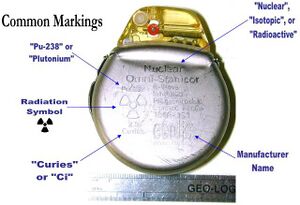Plutonium Powered Pacemaker

Background
Principle of Operation
Thermoelectric Radioactive Decay generators are a long lasting power source that is used in deep space satellites. The principle is you take a concentrated radioactive material like Plutonium that has a relatively short half-life and is thus highly radioactive. The decay of this substance generates significant amounts of heat which is converted into electricity by a thermoelectric generator (through the Peltier effect)
The key advantage of this technology over chemical batteries is that the plutonium lasts significantly longer (potentially 100s of years)
This technology is widely used by NASA for deep space probes, and was once actually used as a power source for implanted heart pacemakers.
There are many examples of these that are found in the world even today. It is probable that not all of them have been properly disposed of.
Brunnhilde: Dog with Nuclear Powered Cardiac Pacemaker

Conceptual Valence
The plutonium pacemaker embodies irony and contradiction. Plutonium is among the most expensive and toxic materials to produce, and is a key component of nuclear weapons. The production and refinement of this material is carefully controlled everywhere in the world.
Even if it weren't radioactive plutonium metal is extremely toxic due to heavy metal toxicity. Furthermore it is highly chemically reactive and is a significant fire hazard (somewhat similar to alkali metals)
So you have the irony that the material most closely associated with the most destructive weapons, that people generally try to go to great lenths to avoid coming into contact with, is being implanted into people's bodies as a power source for a device to regulate the function of their hearts.
The pacemaker has been through several generations of technological improvements and these devices are long obsolete. It is now possible and recommended to remove and replace a dead or defective pacemaker and this is a common medical practice now. The concept that an implant of this nature would be a one-time permanent thing is long gone in the past. People routinely upgrade their implants.
It is also very interesting for being such a compact example of nuclear power from a long time ago. Nuclear power is usually associated with very large scale, expensive facilities with high security and safety costs. The world of miniaturization and biocompatible implants is at the opposite pole.
It suggests that perhaps the path of technological development that was followed was not the only one and that there were other ways of getting there.